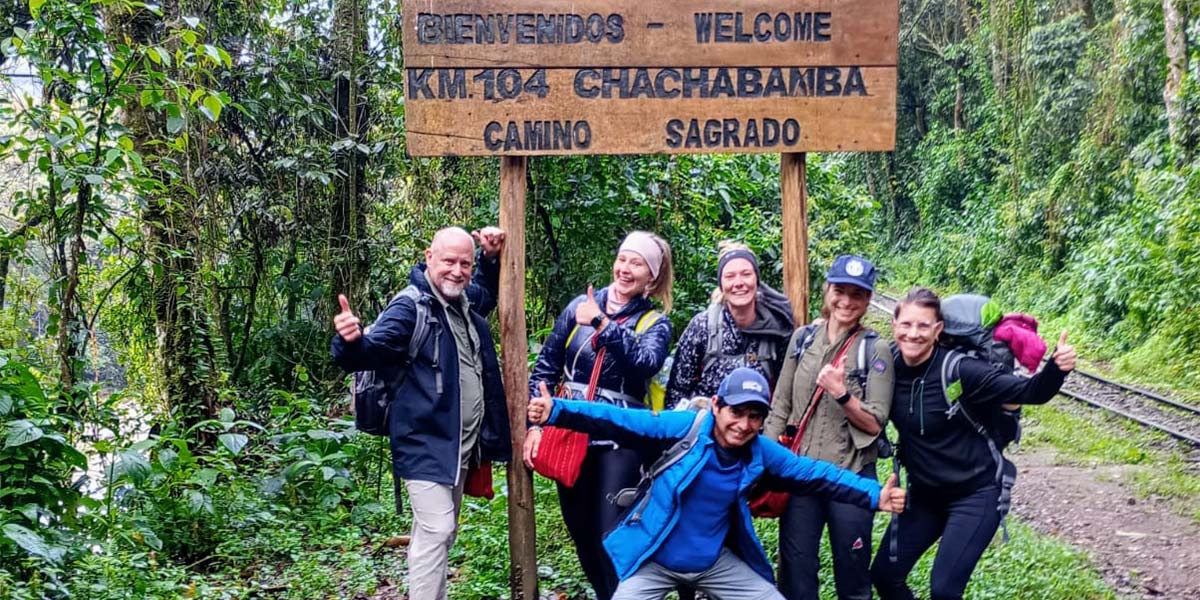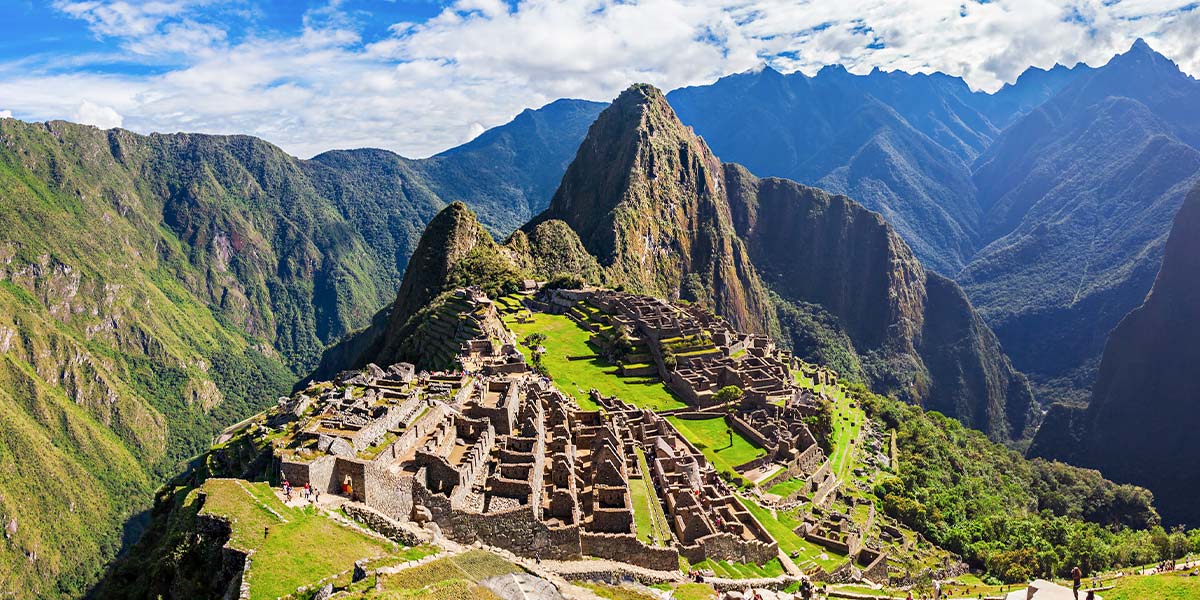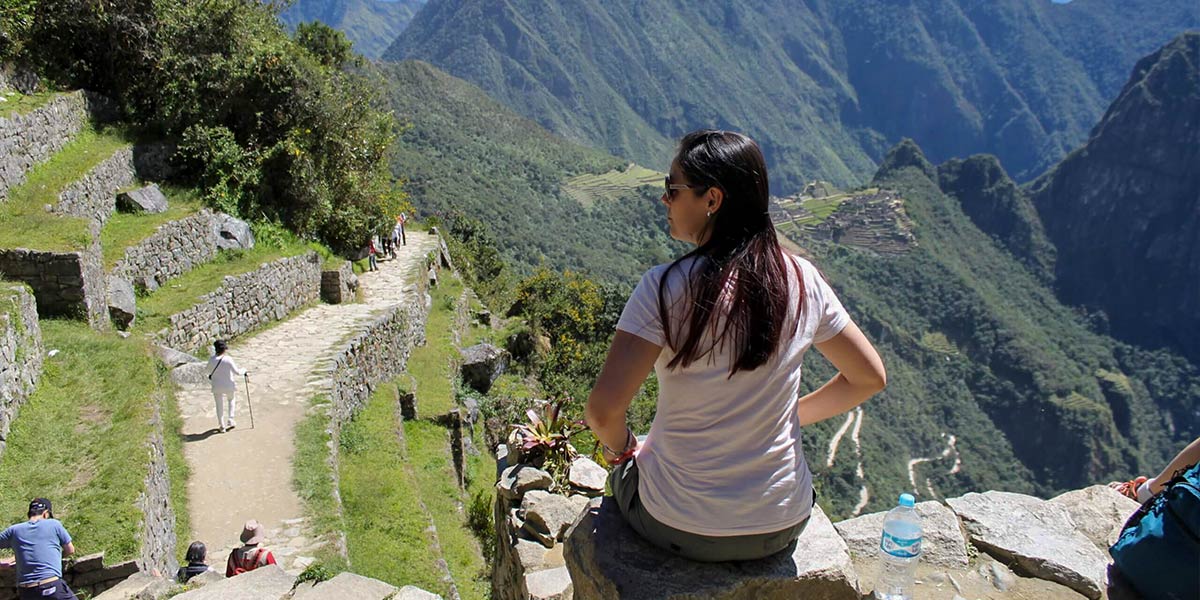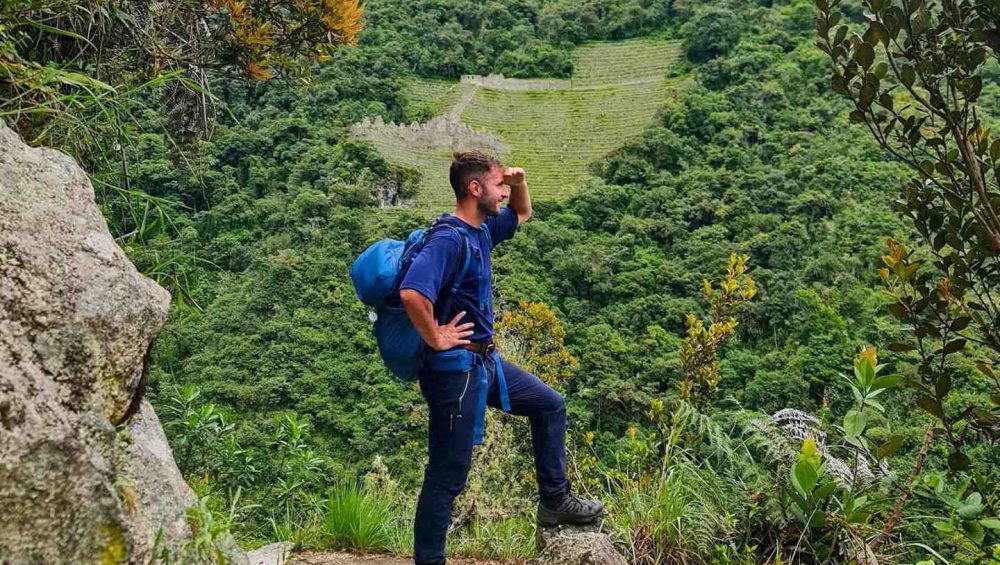The Short Trek to Machu Picchu, also known as the Short Inca Trail, is an ideal experience for those who want to experience part of the ancestral route used by the Incas, in a more accessible version than the classic 4 day tour. This two-day alternative allows you to explore a section of the legendary trail, crossing Andean landscapes and archaeological sites full of history, until finally reaching the majestic Inca citadel of Machu Picchu.
During the route, travelers walk approximately 10 kilometers from kilometer 104 of the railway line, passing through archaeological remains such as Chachabamba and Wiñay Wayna, before reaching the Sun Gate (Inti Punku), from where the citadel is first seen. This two day, one-night tour is designed for those who have less time, but want to live an authentic experience linked to the Inca legacy.
Before embarking on this journey, it is important to keep in mind that the Trek to Machu Picchu starts from the city of Cusco, the starting point for most excursions. So, join us to learn more about the Short Inca Trail, how it is structured, and why it has become an ideal option for those who want to explore Andean heritage on a short trek.
What is the Short Trek to Machu Picchu?
The 2 day Inca Trail is an abbreviated version of the famous ancestral route that leads to the citadel of Machu Picchu. This trek begins at kilometer 104 of the railway line to Aguas Calientes, from where visitors begin a walking tour that crosses the archaeological remains of Chachabamba and Wiñay Wayna. Along the trail, the traveler ascends through the jungle eyebrow vegetation, crossing ancient stone paths built by the Incas, until reaching Inti Punku, the Sun Gate, from where a first panoramic view of Machu Picchu is obtained. The first day ends with an overnight stay in Machu Picchu Town. The second day is dedicated to calmly exploring the Inca city.
This route is part of the original Inca Trail network, which was used by the ancient inhabitants of the Inca Empire as a ceremonial access route to Machu Picchu. Each stone on the path preserves the legacy of a civilization that knew how to dominate the Andean geography. Despite its short duration, the tour allows you to walk on the same paths built more than 500 years ago, used by nobles, priests, and messengers. The short trek offers an authentic experience, where history, architecture, and nature are presented in harmony along a route that is part of the cultural heritage of humanity.

Detailed Itinerary
Day 1: Cusco – Km 104 – Wiñay Wayna – Inti Punku – Aguas Calientes
The first day starts early with the transfer from Cusco or the Sacred Valley to kilometer 104 of the railway, the entry point to the short Inca Trail. From here, you cross a bridge over the Urubamba River to begin the uphill hike towards the archaeological complex of Chachabamba, a ceremonial site featuring platforms, enclosures, and water channels. The route continues uphill through stone staircases and paths surrounded by vegetation until reaching Wiñay Wayna, one of the most prominent archaeological sites on the Inca Trail. This complex is built on terraces and features residential and religious structures that reveal Andean planning in perfect relation to the environment.
After lunch, the journey continues to Inti Punku, the ancient Sun Gate, which offers one of the first panoramic views of Machu Picchu from above. This final part of the day is lighter compared to the initial ascent, although it still requires effort and attention. After descending from Inti Punku, you arrive at the town of Aguas Calientes, where you spend the night before the big day of visiting the citadel.
Day 1 Summary:
- Approximate distance: 11 km
- Total duration: 6 to 7 hours
- Maximum altitude: 2,720 m.a.s.l. (Inti Punku)
- Difficulty: Moderate, with demanding sections during the initial ascent
Day 2: Aguas Calientes – Machu Picchu – Return
The second day begins very early to take the first bus to Machu Picchu. Upon arrival at the entrance, the guided tour begins according to the chosen circuit; most people opt for Circuit 2 Machu Picchu, the most complete circuit of the archaeological site. This tour allows you to see the main sectors of the citadel, including the Sun Temple, the Temple of the Three Windows, the Sacred Plaza, the agricultural terraces, and the water fountains.
An interesting fact about Circuit 2 is that, due to its design, it allows for a general view of Machu Picchu from the highest points, in addition to offering access to the main temples. At the end of the tour, you return to Aguas Calientes by bus. From there, you take the train back to Ollantaytambo and finally road transport to Cusco.
Day 2 Summary:
- Approximate distance (walk within the complex): 3 to 4 km
- Total tour duration: 2 to 3 hours (Circuit 2)
- Maximum altitude: 2,430 m.a.s.l. (Machu Picchu)
- Difficulty: Easy, with some sections of stairs and uneven terrain
Main attractions of the route
During the trek to Machu Picchu, travelers have the opportunity to discover some of the most representative archaeological sites of the Inca legacy. Along this route, a section of the Inca Trail is covered, passing through high jungle landscapes, ancient stone paths, and agricultural terraces, until reaching the Inca Citadel of Machu Picchu. These are the main attractions of the route:
1. Archaeological site of Chachabamba
Located at Km 104, the archaeological site of Chachabamba marks the beginning of the short walk along the Inca Trail. This classic Inca-style construction is made up of carved stone enclosures, a system of canals, and a ceremonial altar. Its proximity to the Urubamba River and its architecture oriented towards natural elements reinforce its spiritual importance on the route to Machu Picchu.
2. Wiñay Wayna Complex
The Wiñay Wayna complex is one of the most outstanding sections of the Inca Trail. These Inca ruins are built on a steep slope and show an impressive combination of agricultural terraces, ceremonial fountains, and residential enclosures. Its name means “forever young” in Quechua, and reflects both the beauty of the place and its ancestral energy.
3. Sun Gate – Inti Punku
The Inti Punku, or Sun Gate, was the ancient entrance to Machu Picchu for those arriving via the Inca Trail. From this point, hikers have a privileged view of the citadel, framed by the mountains and the jungle. This portal served as an entry control to the sacred sanctuary of the Inca Empire, and its location is astronomically aligned with the summer solstice, which highlights its ceremonial function.
4. Machu Picchu
The tour culminates in the Inca Citadel of Machu Picchu, one of the 7 wonders of the modern world. This architectural gem stands on a promontory between the peaks of Huayna Picchu and Machu Picchu Mountain, near the town of Aguas Calientes. By exploring its temples, plazas, royal enclosures, and agricultural areas, it is possible to appreciate the precision of its stone constructions and the wisdom with which they were integrated into the natural environment. Places like the Temple of the Sun, the Temple of the Three Windows, and the Sacred Rock are some of its most significant structures.

Difficulty Level
- Duration and Distance
The short walk to Machu Picchu covers an approximate distance of 12 kilometers and is completed in a single day of walking. On average, the journey takes between 6 and 7 hours, depending on the group’s pace and each person’s physical condition. Although it is a reduced version of the traditional Inca Trail, it is still a demanding experience due to its uphill route and altitude.
- Terrain Conditions
The trail is made up of sections of stone steps, narrow paths, and varying slopes. Some sections have steep ascents and descents that require attention, especially during the rainy season. The terrain can be wet or slippery in some parts, so it is recommended to wear appropriate footwear and have good balance and stability when walking. - Recommendations for people with moderate mobility
For those with moderate mobility or who are not used to frequent exercise, it is advisable to do previous walks before the excursion and stay at least two days in Cusco or the Sacred Valley before starting the journey. This allows for acclimatization and improved physical endurance. It is also essential to maintain your own pace, hydrate constantly, and not carry unnecessary weight.
Requirements and Permits
Before taking the short walk to Machu Picchu, it is important to meet certain requirements established by the Peruvian authorities. These ensure the conservation of the Inca Trail and the safety of those who travel it.
Short Inca Trail Entrance Ticket
This ticket allows access from kilometer 104 of the railway to the city of Machu Picchu, passing through archaeological sites such as Chachabamba and Wiñay Wayna. It is mandatory to purchase it through an authorized agency, as access is only allowed in the company of an official guide.
Machu Picchu Entrance Ticket
In addition to access to the trail, an additional ticket is required to visit the Inca citadel. This Machu Picchu ticket is usually included in the package offered by the operating agency and allows access to the main sectors of the archaeological complex the day after the walk. There are different circuits, so it is important to verify which one is included.
Peruvian Government Rules and Limited Number of Spaces
The Peruvian government has established a daily limit for entry to the short Inca Trail, with a maximum of 250 people per day, including guides and porters. This measure seeks to preserve the natural and archaeological environment. For this reason, it is mandatory to do the walk through an authorized agency, which is responsible for processing permits and following established regulations.

When to Book?
It is recommended to book the tour at least 2 or 3 months in advance, especially during the high season (May to September). Spaces sell out quickly due to high demand and the limited number of daily spots. The sooner you book, the greater the chance of securing your desired date.
Best time for the trek
The short trek to Machu Picchu can be done almost all year round, but there are certain months when the weather favors a more comfortable and safe experience. The dry season, from May to September, is preferred by many visitors due to the low probability of rain. During this period, the sky is usually clear, which allows for better appreciation of the landscape and archaeological sites along the way.
On the other hand, the rainy season, from November to March, presents wet trails, more cloudiness, and frequent rainfall. These conditions can make the journey difficult and reduce visibility, although they also offer greener vegetation and fewer crowds.
In February, the Inca Trail remains closed for maintenance. If you plan the trek for January or March, it is important to be prepared for heavy rains and consult with the travel agency if there are risks of temporary closure.
Weather considerations
The climate in the region is variable. Therefore, even in the dry season, isolated rains may occur. It is advisable to be prepared for sudden changes in temperature. During the day, the sun can be strong, while in the morning and at dusk, the cold is felt more intensely, especially in higher altitude areas.
What to bring
Adequate preparation is key to enjoying this trek. Carrying what is necessary in a comfortable and light backpack will make a difference during the journey.
Recommended equipment and clothing list
- Trekking shoes or comfortable boots, preferably waterproof
- Hiking pants and quick-drying shirts
- Waterproof and windproof jacket
- Hat or cap for the sun
- Sunglasses with UV protection
- Sunscreen and insect repellent
- Trekking poles (optional but useful on descents)
Recommendations for light backpacks
The ideal backpack should be 20 to 30 liters and fit well to the body. It is advisable to carry only the essentials for the two days, as the short trek does not require heavy loads. You can include:
- A change of light clothes
- Underwear and spare socks
- Poncho or rain cape
- Reusable water bottle (1 to 2 liters)
- Energy snacks such as bars, dried fruit, or chocolates
- Headlamp or small lamp
Mandatory documentation
- Original passport (valid and in good condition)
- Identity document (if applicable for Mercosur citizens)
- Inca Trail entrance ticket
- Machu Picchu entrance ticket
- Train ticket (round trip)
- Tour voucher (if booked through an agency)

